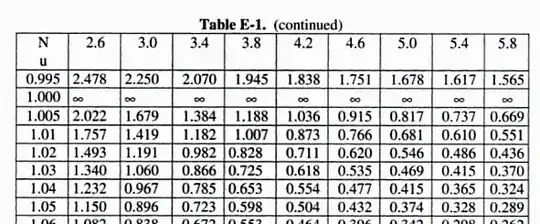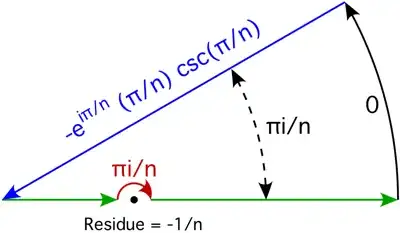I can at least give your integral a name. Suppose $0 \leq x<1$ so that the integral converges.
Letting $u = v^{1/n}$, the integral becomes
$$
\frac{1}{n} \int_0^{x^n} v^{\frac{1}{n}-1}(1-v)^{-1}\,dv = \frac{1}{n}B\left(x^n;\,\frac{1}{n},\,0\right),
$$
where $B(z;p,q)$ is the incomplete beta function. According to MathWorld, we can also write this as a hypergeometric function:
$$
x\cdot{}_2F_1\left(\frac{1}{n},\,1;\,\frac{1}{n}+1;\,x^n\right).
$$
It appears (based on numerical evidence) that the principal value of the integrand is given by
$$
\text{PV} \int_0^x \frac{du}{1-u^n} = \operatorname{Re}\left[x\cdot{}_2F_1\left(\frac{1}{n},\,1;\,\frac{1}{n}+1;\,x^n\right)\right].
$$
This is in regards to the table posted in the question. They are not using the principal value of the integral; they are using a related quantity which differs from the principal value by a function depending only on $n$.
Let $0 < \epsilon < \min\{1,x-1\}$ and split the integral up into two parts,
$$
\begin{align*}
&\int_0^{1-\epsilon} \frac{du}{1-u^n} + \int_{1+\epsilon}^{x} \frac{du}{1-u^n} \\
&\qquad = (1-\epsilon)\cdot{}_2F_1\left(\frac{1}{n},\,1;\,\frac{1}{n}+1;\,(1-\epsilon)^n\right) + \int_{1+\epsilon}^{x} \frac{du}{1-u^n}.
\end{align*}
$$
Making the substitution $u=1/v$ in the remaining integral gives
$$
\begin{align*}
\int_{1+\epsilon}^{x} \frac{du}{1-u^n} &= -\int_{1/x}^{1/(1+\epsilon)}\frac{v^{n-2}}{1-v^n}\,dv \\
&= \int_0^{1/x}\frac{v^{n-2}}{1-v^n}\,dv - \int_0^{1/(1+\epsilon)}\frac{v^{n-2}}{1-v^n}\,dv.
\end{align*}
$$
Both of these integrals are treated the same way. We proceed as before, letting $v=w^{1/n}$. This gives
$$
\begin{align*}
\int_0^a \frac{v^{n-2}}{1-v^n}\,dv &= \frac{1}{n} \int_0^{a^n} w^{\frac{n-1}{n}-1} (1-w)^{-1}\,dw \\
&= \frac{a^{n-1}}{n-1}\, {}_2F_1\left(1-\frac{1}{n},\,1;\,2-\frac{1}{n};\,a^n\right),
\end{align*}
$$
so that
$$
\begin{align*}
\int_{1+\epsilon}^{x} \frac{du}{1-u^n} &= \frac{x^{1-n}}{n-1}\, {}_2F_1\left(1-\frac{1}{n},\,1;\,2-\frac{1}{n};\,x^{-n}\right) \\
&\qquad - \frac{(1+\epsilon)^{1-n}}{n-1}\, {}_2F_1\left(1-\frac{1}{n},\,1;\,2-\frac{1}{n};\,(1+\epsilon)^{-n}\right).
\end{align*}
$$
Thus
$$
\text{PV} \int_0^x \frac{du}{1-u^n} = \frac{x^{1-n}}{n-1}\, {}_2F_1\left(1-\frac{1}{n},\,1;\,2-\frac{1}{n};\,x^{-n}\right) + f(n),
\tag{1}
$$
where
$$
\begin{align*}
f(n) &= \lim_{\epsilon \to 0} \left\{(1-\epsilon)\cdot{}_2F_1\left(\frac{1}{n},\,1;\,\frac{1}{n}+1;\,(1-\epsilon)^n\right) \right. \\
&\qquad\qquad\qquad \left. - \frac{(1+\epsilon)^{1-n}}{n-1}\, {}_2F_1\left(1-\frac{1}{n},\,1;\,2-\frac{1}{n};\,(1+\epsilon)^{-n}\right)\right\} \\
&= \frac{\pi}{n} \cot\left(\frac{\pi}{n}\right)
\tag{2}
\end{align*}
$$
if $n>1$. The last equality $(2)$ follows directly from robjohn's work by letting $x \to \infty$ in $(1)$. So, in summary,
For $x<1$,
$$
\int_0^x \frac{du}{1-u^n} = x\cdot{}_2F_1\left(\frac{1}{n},\,1;\,\frac{1}{n}+1;\,x^n\right),
$$
and for $x>1$ and $n>1$,
$$
\text{PV} \int_0^x \frac{du}{1-u^n} = \frac{x^{1-n}}{n-1}\, {}_2F_1\left(1-\frac{1}{n},\,1;\,2-\frac{1}{n};\,x^{-n}\right) + \frac{\pi}{n} \cot\left(\frac{\pi}{n}\right).
$$
In computing their table, they seem to have assumed that $f(n) = 0$. Indeed, their table is exactly equal to the one generated by
$$
g(n,x) = \text{PV} \int_0^x \frac{du}{1-u^n} - \frac{\pi}{n} \cot\left(\frac{\pi}{n}\right).
$$
For example,
$$
\begin{align*}
g(2.6,1.01) &\approx 1.75625, \\
g(2.6,1.02) &\approx 1.4927, \\
g(2.6,1.03) &\approx 1.33979, \\
g(2.6,1.04) &\approx 1.23215, \\
g(2.6,1.05) &\approx 1.14932.
\end{align*}
$$

